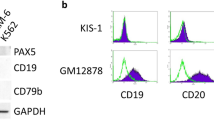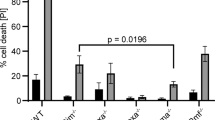Abstract
Chromosomal rearrangements in non-Hodgkin's B-cell lymphoma implicate BCL-6 as an oncogene, yet direct evidence for BCL-6 acting as an oncogene in B cells has been lacking. Here, we show that BCL-6 can immortalize primary B cells, but only in the absence of p53 tumor suppressor function. The expression of BCL-6 led to greatly increased B-cell proliferation, particularly in response to CD40 stimulation. Furthermore, BCL-6-infected p53-deficient B cells gave rise to immortalized cell lines that could be maintained by CD40 stimulation. We found that in primary mouse B cells, BCL-6 repressed expression of the Blimp-1, p27kip1, and cyclin D2 target genes. BCL-6 did not markedly repress the PDCD2 and BCL-XL target genes. The BCL-6 immortalized cell lines had a phenotype consistent with germinal center B cells, they expressed the germinal center-specific M17 gene, and a significant fraction of the cells stained positive with PNA. Our data indicate that BCL-6 may act to maintain B cells in a germinal center-like state, and repression of Blimp-1 by BCL-6 may be particularly crucial for stabilization of the germinal center phenotype. Our data also suggest that disruption of the p53 pathway may be crucial for the development of BCL-6-expressing B-cell lymphomas.
This is a preview of subscription content, access via your institution
Access options
Subscribe to this journal
Receive 50 print issues and online access
$259.00 per year
only $5.18 per issue
Buy this article
- Purchase on Springer Link
- Instant access to full article PDF
Prices may be subject to local taxes which are calculated during checkout




Similar content being viewed by others
References
Akasaka T, Akasaka H, Ueda C, Yonetani N, Maesako Y, Shimizu A, Yamabe H, Fukuhara S, Uchiyama T and Ohno H . (2000). J. Clin. Oncol., 18, 510–518.
Albagli-Curiel O . (2003). Oncogene, 22, 507–516.
Baron BW, Anastasi J, Thirman MJ, Furukawa Y, Fears S, Kim DC, Simone F, Birkenbach M, Montag A, Sadhu A, Zeleznik-Le N and McKeithan TW . (2002). Proc. Natl. Acad. Sci. USA, 99, 2860–2865.
Bellido M, Capello D, Altes A, Estivill C, Gaidano G, Pujol R, Bordes R, Baiget M, Saglio G, Sierra J and Nomdedeu JF . (2002). Haematologica, 87, 908–917.
Bereshchenko OR, Gu W and Dalla-Favera R . (2002). Nat. Genet., 32, 606–613.
Cervenak L, Magyar A, Boja R and Laszlo G . (2001). Immunol. Lett., 78, 89–96.
Christoph T, Rickert R and Rajewsky K . (1994). Int. Immunol., 6, 1203–1211.
Dalla-Favera R, Ye BH, Lo Coco F, Gaidano G, Lista F, Knowles DM, Louie DC, Offit K and Chaganti RS . (1994). Ann. Oncol., 5, 55–60.
Dent AL, Vasanwala FH and Toney LM . (2002). Crit. Rev. Oncol. Hematol., 41, 1–9.
el-Deiry WS . (1998). Semin. Cancer Biol., 8, 345–357.
Fanzo JC, Hu CM, Jang SY and Pernis AB . (2003). J. Exp. Med., 197, 303–314.
Gupta S, Jiang M, Anthony A and Pernis AB . (1999). J. Exp. Med., 190, 1837–1848.
Katz P, Whalen G and Kehrl JH . (1994). J. Biol. Chem., 269, 16802–16809.
Lin Y, Wong K and Calame K . (1997). Science, 276, 596–599.
Lossos IS, Jones CD, Warnke R, Natkunam Y, Kaizer H, Zehnder JL, Tibshirani R and Levy R . (2001). Blood, 98, 945–951.
MacLennan IC . (1994). Annu. Rev. Immunol., 12, 117–139.
Messika EJ, Lu PS, Sung YJ, Yao T, Chi JT, Chien YH and Davis MM . (1998). J. Exp. Med., 188, 515–525.
Moller MB, Ino Y, Gerdes AM, Skjodt K, Louis DN and Pedersen NT . (1999). Leukemia, 13, 453–459.
Muramatsu M, Sankaranand VS, Anant S, Sugai M, Kinoshita K, Davidson NO and Honjo T . (1999). J. Biol. Chem., 274, 18470–18476.
Reljic R, Wagner SD, Peakman LJ and Fearon DT . (2000). J. Exp. Med., 192, 1841–1848.
Shaffer AL, Yu X, He Y, Boldrick J, Chan EP and Staudt LM . (2000). Immunity, 13, 199–212.
Shvarts A, Brummelkamp TR, Scheeren F, Koh E, Daley GQ, Spits H and Bernards R . (2002). Genes Dev., 16, 681–686.
Starostik P, Greiner A, Schultz A, Zettl A, Peters K, Rosenwald A, Kolve M and Muller-Hermelink HK . (2000). Blood, 95, 1180–1187.
Staudt LM, Dent AL, Shaffer AL and Yu X . (1999). Int. Rev. Immunol., 18, 381–403.
Tang TT, Dowbenko D, Jackson A, Toney L, Lewin DA, Dent AL and Lasky LA . (2002). J. Biol. Chem., 277, 14255–14265.
Toney LM, Cattoretti G, Graf JA, Merghoub T, Pandolfi PP, Dalla-Favera R, Ye BH and Dent AL . (2000). Nat. Immunol., 1, 214–220.
Volpe G, Vitolo U, Carbone A, Pastore C, Bertini M, Botto B, Audisio E, Freilone R, Novero D, Cappia S, De Giuli P, Mazza U, Resegotti L, Palestro G, Saglio G and Gaidano G . (1996). Genes Chromosomes Cancer, 16, 21–30.
Ye BH, Chaganti S, Chang CC, Niu H, Corradini P, Chaganti RS and Dalla-Favera R . (1995). EMBO J., 14, 6209–6217.
Yu D and Thomas-Tikhonenko A . (2002). Oncogene, 21, 1922–1927.
Acknowledgements
This work was supported by a V Foundation Scholar Award to ALD. We thank Dr Andrei Thomas-Tikhonenko (University of Pennsylvania) for the kind gift of the pJ11 JH probe.
Author information
Authors and Affiliations
Corresponding author
Rights and permissions
About this article
Cite this article
Kusam, S., Vasanwala, F. & Dent, A. Transcriptional repressor BCL-6 immortalizes germinal center-like B cells in the absence of p53 function. Oncogene 23, 839–844 (2004). https://doi.org/10.1038/sj.onc.1207065
Received:
Revised:
Accepted:
Published:
Issue Date:
DOI: https://doi.org/10.1038/sj.onc.1207065
Keywords
This article is cited by
-
Combinatorial analyses reveal cellular composition changes have different impacts on transcriptomic changes of cell type specific genes in Alzheimer’s Disease
Scientific Reports (2021)
-
Loss of PRDM1/BLIMP-1 function contributes to poor prognosis of activated B-cell-like diffuse large B-cell lymphoma
Leukemia (2017)
-
Control systems and decision making for antibody production
Nature Immunology (2010)
-
Axon growth and guidance genes identify T‐dependent germinal centre B cells
Immunology & Cell Biology (2008)
-
Conserved alternative and antisense transcripts at the programmed cell death 2 locus
BMC Genomics (2007)



